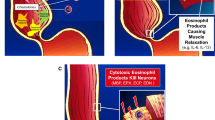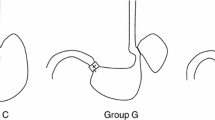Abstract
Neurotensin (NT) decreases lower esophageal sphincter pressure and impedes gastric emptying, thus exacerbating gastroesophageal reflux. The aim was to determine the content of esophageal tissue NT in patients with erosive esophagitis compared to those with normal endoscopy with or without abnormal acid exposure. Consecutive patients (N = 21) with gastroesophageal reflux disease symptoms underwent an upper endoscopy, at which two biopsies from opposite walls were obtained from normal-appearing mucosa. Patients with normal upper endoscopy underwent a pH test. NT tissue content was determined using radioimmunoassay. Six patients had erosive esophagitis, seven normal endoscopy but abnormal acid exposure, and eight both normal upper endoscopy and normal acid exposure. The NT/protein ratio was significantly higher in patients with normal upper endoscopy and normal or abnormal pH test compared to those with erosive esophagitis (8.7±1.4 and 8.0±1.2 vs. 3.8±0.5, respectively; P < 0.01). There was no significant difference in NT/protein ratio in patients with normal upper endoscopy with versus those without abnormal acid exposure (P = 0.7). There was no correlation between the extent of acid exposure and the NT/protein ratio. We suggest that the lower tissue content detected in patients with erosive esophagitis may represent a local protective mechanism against gastroesophageal reflux.
Similar content being viewed by others
REFERENCES
Azpiroz F, Malagelada JR: Intestinal control of gastric tone. Am J Physiol 249:G501–G509, 1985
Spiller RC, Trotman IF, Adrian TE, Bloom SR, Misiewicz JJ, Silk DB: Further characterisation of the 'ileal brake' reflex in man-Effect of ileal infusion of partial digests of fat, protein, and starch on jejunal motility and release of neurotensin, enteroglucagon, and peptide YY. Gut 29:1042–1051, 1988
Carraway R, Leeman SE: Characterization of radioimmunoassayable neurotensin in the rat. Its differential distribution in the central nervous system, small intestine, and stomach. J Biol Chem 251:7045–7052, 1976
Ferris CF: Neurotensin. In Handbook of Physiology. The Gastrointestinal System. Bethesda, MD, American Physiological Society, 1989, pp 559–586
Sundler F, Hakanson R, Hammer RA, Alumets J, Carraway R, Leeman SE, Zimmerman EA: Immunohistochemical localization of neurotensin in endocrine cells of the gut. Cell Tissue Res 178:313–321, 1977
Rosell S, Rokaeus A: The effect of ingestion of amino acids, glucose and fat on circulating neurotensin-like immunoreactivity (NTLI) in man. Acta Physiol Scand 107:263–267, 1979
Ferris CF, Hammer RA, Leeman SE. Elevation of plasma neurotensin during lipid perfusion of rat small intestine. Peptides 2:263–266, 1981
Rosell S, Thor K, Rokaeus A, Nyquist O, Lewenhaupt A, Kager L, Folkers K: Plasma concentration of neurotensin-like immunoreactivity (NTLI) and lower esophageal sphincter (LES) pressure in man following infusion of (Gln4)-neurotensin. Acta Physiol Scand 109:369–375, 1980
Andersson S, Rosell S, Hjelmquist U, Chang D, Folkers K: Inhibition of gastric and intestinal motor activity in dogs by (Gln4) neurotensin. Acta Physiol Scand 100:231–235, 1977
Gui X, Dobner PR, Carraway RE: Endogenous neurotensin facilitates enterohepatic bile acid circulation by enhancing intestinal uptake in rats. Am J Physiol Gastrointest Liver Physiol 281:G1413–G1422, 2001
Schwizer W, Hinder RA, DeMeester TR: Does delayed gastric emptying contribute to gastroesophageal reflux disease? Am J Surg 157:74–81, 1989
Mittal RK, Holloway RH, Penagini R, Blackshaw LA, Dent J: Transient lower esophageal sphincter relaxation. Gastroenterology 109:601–610, 1995
Carraway R, Cochrane DE, Lansman JB, Leeman SE, Paterson BM, Welch HJ: Neurotensin stimulates exocytotic histamine secretion from rat mast cells and elevates plasma histamine levels. J Physiol 323:403–414, 1982
Goldman R, Bar-Shavit Z, Shezen E, Terry S, Blumberg S: Enhancement of phagocytosis by neurotensin, a newly found biological activity of the neuropeptide. Adv Exp Med Biol 155:133–141, 1982
Moore RN, Osmand AP, Dunn JA, Joshi JG, Koontz JW, Rouse BT: Neurotensin regulation of macrophage colony-stimulating factors-stimulated in vitro myelopoisesis. J Immunol 142:2689–2694, 1989
De la Fuente M, Garrido JJ, Arahuetes RM, Hernanz A: Stimulation of phagocytic function in mouse macrophages by neurotensin and neuromedin N. J Neuroimmunol 42:97–104, 1993
Carraway RE, Mitra SP: Binding and biologic activity of neurotensin in guinea pig ileum. Peptides15:1451–1459, 1994
Castagliuolo I, Leeman SE, Bartolak-Suki E, Nikulasson S, Qiu B, Carraway RE, Pothoulakis C: A neurotensin antagonist, SR 48692, inhibits colonic responses to immobilization stress in rats. Proc Natl Acad Sci USA 93:12611–12615, 1996
Castagliuolo I, Wang CC, Valenick L, Pasha A, Nikulasson S, Carraway RE, Pothoulakis C: Neurotensin is a proinflammatory neuropeptide in colonic inflammation. J Clin Invest 103:843–849, 1999
Perdikis G, Wilson P, Hinger RA, Redmond EJ, Wetscher GJ, Saeki S, Adrian TE: Gastroesophageal reflux disease is associated with enteric hormone abnormalities. Am J Surg167:186–191, 1994
Gadenstatter M, Prommegger R, Klingler A, Schwelberger H, Weiss HG, Glaser K, Wetscher GJ: Alterations of gut neuropeptides in gastroesophageal reflux disease are resolved after antireflux surgery. Am J Surg 180:483–486, 2000
Hetzel DJ, Dent J, Reed WD, Narielvala FM, Mackinnon M, McCarthy JH, Mitchell B, Beveridge BR, Laurence BH, Gibson GG, et al.: Healing and relapse of severe peptic esophagitis after treatment with omeprazole. Gastroenterology 95:903–912, 1988
Wiener GJ, Morgan TM, Copper JB, Wu WC, Castell DO, Sinclair JW, Richter JE:Ambulatory 24-hour esophageal pH monitoring. Reproducibility and variability of pH parameters. Dig Dis Sci 33:1127–1133, 1988
Carraway RE, Mitra SP, Evers BM, Townsend CM Jr: BON cells display the intestinal pattern of neurotensin/neuromedin N precursor processing. Regul Pept 53:17–29, 1994
Yamashita Y, Pedersen JH, Hansen CP: Distribution of neurotensin-like immunoreactivities in porcine and human gut. Scand J Gastroenterol 25:481–488, 1990
Lewin KJ, Riddell RH, Weinstein WM: Inflammatory disorders of the esophagus, reflux and nonreflux type. In Gastrointestinal Pathology and Its Clinical Implications. New York, Igaku-Shoin, 1992, pp 401–439
Funch-Jensen P, Kock K, Christensen LA, Fallingborg J, Kjaergaard JJ, Andersen SP, Teglbjaerg PS: Microscopic appearance of the esophageal mucosa in a consecutive series of patients submitted to upper endoscopy. Correlation with gastroesophageal reflux symptoms and macroscopic findings. Scand J Gastroenterol 21:65–69, 1986
Schindlbeck NE, Wiebecke B, Klauser A, Voderholzer WA, Muller-Lissner SA: Diagnostic value of histology in non-erosive gastrooesophageal reflux disease. Gut39:151–154, 1996
D'Eufemia P, Corrado G, Finocchiaro R, Celli M, Cavaliere M, Troiani P, Tote J, Cardi E, Giardini O: Increased taurine content in esophageal mucosa of children affected by gastroesophageal reflux. Dig Dis Sci 46:808–814, 2001
Author information
Authors and Affiliations
Rights and permissions
About this article
Cite this article
Dekel, R., Carraway, R.E., Green, C. et al. The Relationship Between the Esophageal Tissue Content of Neurotensin and the Presence or Absence of Esophageal Inflammation. Dig Dis Sci 49, 42–47 (2004). https://doi.org/10.1023/B:DDAS.0000011600.60709.a1
Issue Date:
DOI: https://doi.org/10.1023/B:DDAS.0000011600.60709.a1




